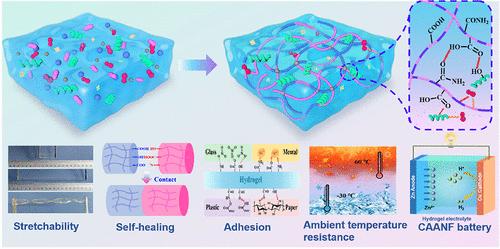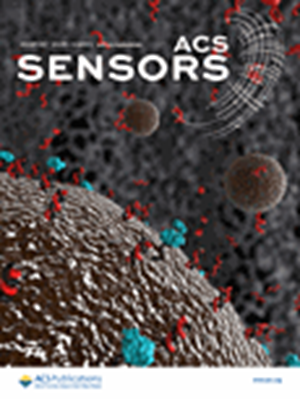Highly Stretchable, Tough, and Transparent Chitin Nanofiber-Reinforced Multifunctional Eutectogels for Self-Powered Wearable Sensors
IF 8.2
1区 化学
Q1 CHEMISTRY, ANALYTICAL
引用次数: 0
Abstract
Traditional conductive hydrogels have disadvantages for wearable sensors, such as poor electrical conductivity, weak mechanical properties, narrow application temperature range, and required external power supply, which limit their wide application. However, manufacturing hydrogel sensors with excellent mechanical properties and self-adhesive, temperature-resistant, and self-powered properties remains a challenge. Herein, chitin nanofiber-reinforced eutectogels (CAANF) with self-adhesive, self-healing, transparent, environment tolerant, and good mechanical properties were obtained via a simple one-pot method with the deep eutectic solvent (DES) system composed of acrylic acid, acrylamide, and choline chloride (ChCl). High-density hydrogen bond networks between CAANFs can act as strong cross-linking sites, conferring high stretchability (1680%) and elasticity. Moreover, high-density hydrogen bond networks with dynamic reversibility can provide excellent self-healing and adhesion abilities. Due to the unique properties of DES, CAANF eutectic gels also exhibit good ionic conductivity and environmental resistance, allowing the sensor to be applied over a wide temperature range (−30 to 60 °C). Additionally, CAANF-based self-powered flexible sensors can be used to detect human movement, monitor health status, and transmit signals for the encryption and decryption of information according to the Morse code. This work expands the scope of portable applications in the field of wearable electronic devices.

求助全文
约1分钟内获得全文
求助全文
来源期刊

ACS Sensors
Chemical Engineering-Bioengineering
CiteScore
14.50
自引率
3.40%
发文量
372
期刊介绍:
ACS Sensors is a peer-reviewed research journal that focuses on the dissemination of new and original knowledge in the field of sensor science, particularly those that selectively sense chemical or biological species or processes. The journal covers a broad range of topics, including but not limited to biosensors, chemical sensors, gas sensors, intracellular sensors, single molecule sensors, cell chips, and microfluidic devices. It aims to publish articles that address conceptual advances in sensing technology applicable to various types of analytes or application papers that report on the use of existing sensing concepts in new ways or for new analytes.
 求助内容:
求助内容: 应助结果提醒方式:
应助结果提醒方式:


